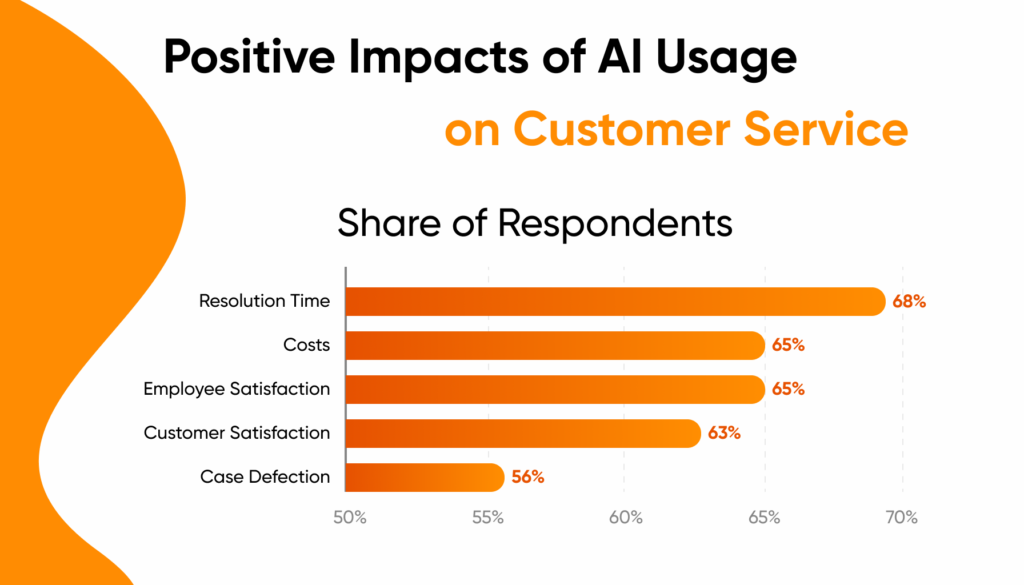5 AI Hacks to Elevate Your Customer Game
A I • Jul 05,2024

What You’ll Discover:
- 1. Chatbots
- 2. Predictive Customer Service
- 3. Sentiment Analysis
- 4. Voice Analysis
- 5. Quality Control
- 6. Conclusion
Remember the days of endlessly waiting on hold, only to be greeted by a robotic voice that can’t understand your request? Thankfully, those days are fading fast. Artificial intelligence (AI) rapidly transforms customer service, offering businesses a powerful tool to escape the purgatory of slow response times and frustrated customers.
However, AI isn’t here to steal human agents’ jobs. Data from Statista shows a significant impact: 70% of customer service leaders reported faster resolution times thanks to AI. But the benefits go beyond speed. A staggering 65% of respondents also reported a positive impact on costs and employee satisfaction. AI frees human agents to tackle complex issues and build personalized customer relationships, while reducing operational costs and boosting employee morale.
This article will equip you with the knowledge to use AI in customer service operations. We’ll delve into practical strategies, showcase real-world examples, and show how AI can empower your team, enhance customer experiences, and drive business success.
Top 5 Ways to Use AI in Customer Service
Ready to revolutionize your customer service department? AI offers many innovative solutions to help you enhance customer experiences, boost efficiency, and save costs. Here are five ways you can leverage AI to take your business to the next level:
1. Chatbots: Beyond Basic Responses
Forget clunky, scripted chatbots! AI-powered chatbots are the fantastic new colleagues in customer service, using real-time smarts to understand and respond to customer questions.
Here’s the magic: Natural language processing (NLP) and machine learning allow these chatbots to have conversations, not just follow scripts. They can answer basic questions, guide customers through your website, and even troubleshoot common problems with a human-like touch.

Real-life Examples
Nova KBM, a leading Slovenian financial institution, implemented AI-powered chatbots to streamline customer service. This innovative solution automated basic inquiries and empowered self-service, leading to a staggering 94% automation rate. This resulted in a dramatic 75% reduction in live agent chats and a 65% increase in chat containment, leaving customers happier and wait times shorter.
E-commerce giant Alibaba Group leverages AI chatbots to proactively and reactively address customer concerns. This resulted in a stellar 25% jump in customer satisfaction, significantly faster response times, and annual cost savings exceeding $150 million.

2. Predictive Customer Service: AI for Proactive Care
Imagine a world where customer service anticipates your every need. Predictive Customer Service (PCS) makes this a reality. It leverages data and analytics to foresee and proactively address customer problems and needs. Instead of reacting to issues, PCS empowers companies to get ahead of their customers, offering personalized support and recommendations before they even need to ask.
Take a customer who just bought a complex gadget. Two weeks later, they might feel overwhelmed and reach for the help desk. However, with PCS, the retailer can predict this. They can proactively send installation guides or schedule technician calls, empowering the customer and preventing frustration. This is the magic of PCS.

Real-life Examples
Amazon leverages machine learning (ML) and natural language processing (NLP) to anticipate customer preferences. Analyzing past purchases, reviews, and browsing behavior suggests relevant items, such as shoes with features similar to those you’ve browsed.
Domino’s is revolutionizing pizza delivery with AI that predicts customer intent and prepares pizzas in advance. This innovative approach shortens wait times, enhances customer satisfaction, and sets the stage for future predictive ordering and inventory management advancements.
3. Sentiment Analysis: Unmasking Customer Emotions
Sentiment analysis uses AI and language processing to analyze emotions behind reviews, social media posts, and interactions. This technology acts as a digital ear, gauging customer feelings—positive, negative, or neutral—to enable businesses to respond effectively.
Furthermore, AI listens beyond words! Facial emotion recognition uses AI to analyze facial expressions and infer emotions. It recognizes happiness, sadness, anger, surprise, fear, and disgust – a digital gauge of customer feelings. Combined with sentiment analysis from text data, companies understand the customer experience.

Real-life Examples
Italian Bank Boosts Satisfaction with AI Emotion Tracking: A prominent Italian state-owned bank used an AI system to analyze customer facial expressions during interactions with managers, which led to a 15% surge in satisfaction and a 7% cost reduction.
Uber used AI-powered social listening to gauge user reaction to their new app. Online discussions doubled, likes surged 90%, and shares soared 250%, indicating strong user engagement and positive sentiment. This valuable feedback allows Uber to improve the app and attract new users.

4. Voice Analysis: Decoding Tone Behind Words
AI voice analysis goes beyond speech recognition to understand customer emotions. Unlike sentiment analysis, which often struggles with written text, voice analysis can accurately infer customer feelings. This technology complements sentiment analysis, providing a more comprehensive understanding of customer sentiment.
Voice ordering, the ability to place orders using voice commands, offers a hands-free alternative to traditional methods. Voice ordering systems can leverage voice analysis to personalize the ordering process. Imagine a system suggesting a calming beverage based on a customer’s stressed voice or recommending a celebratory movie bundle with a joyful tone.

Real-life Examples
Migros Bank in Switzerland cut call wait times by 20% with a voice AI system. This AI identified callers by voice, offered 24/7 support in multiple languages, and boosted customer satisfaction and security.
Starbucks saw a 16% sales jump by introducing voice-powered coffee ordering through their My Starbucks® barista. This voice commerce strategy proved faster and easier than the app, leading to fewer abandoned orders.
5. Quality Control: Good to Great
Leveraging AI, companies can analyze customer interactions to pinpoint areas for improvement. This technology identifies successful interactions to use as training models and flags areas where reps might need extra guidance.
AI empowers companies to tailor training programs for a more effective customer service team by assessing communication clarity, protocol adherence, and customer satisfaction. This analysis highlights areas where reps excel and might need improvement.

Real-life Example
A Spanish delivery app struggled to assess customer service quality due to limited manual reviews. They implemented an AI system that analyzes all interactions, identifies agent strengths and weaknesses, and detects customer sentiment. This resulted in a 100% review rate, deeper customer insights, and data-driven decisions for improved service.
Future of AI in Customer Support
AI’s undeniable impact on customer service is a game-changer, powering faster resolutions, lower costs, and happier customers. Here’s a closer look at how AI is transforming this field:
- Hyper-Personalization: AI assistants remember your preferences and proactively offer solutions before you even ask.
- Omnichannel Integration: A seamless experience exists across all channels: websites, mobile apps, social media, and stores.
- Emotional Intelligence: AI agents will understand your emotions and interact empathetically.
- Predictive Maintenance: AI will anticipate your needs and solve problems before they arise.
But AI is not here to replace human agents but to empower them. The future of customer service involves AI and human agents working together to create exceptional customer experiences. This human-AI collaboration will be the cornerstone of customer service excellence.
*****
Thanks for reading!
Empower your customer service team and elevate your customer experience with AI.
We would love to hear your thoughts and questions in the comments!
Best regards,
the A1V Lab Team
Previos Article AI Marketing: 10x Growth Engine
Next Article Transforming Higher Education: 6 Use Cases of AI Tools in Universities